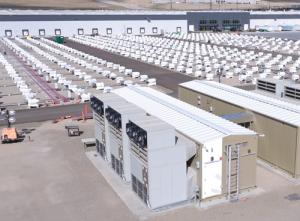Protecting Electricity Customers
Amory Lovins serves Stanford University as Adjunct Professor of Civil and Environmental Engineering (2020–24), Lecturer (2025– ), and Precourt Scholar, Precourt Institute for Energy. He is Cofounder and Chairman Emeritus, RMI (founded as Rocky Mountain Institute).
New artificial intelligence (AI) data centers pose important financial risks to investors and electricity customers. But following conservative economic principles can manage those risks and help both power executives and their regulators.

Data centers’ electricity usage, one-fourth for AI, is approaching five percent of total U.S. use. A few localities, notably two Virginia counties with the world’s densest cluster of data centers, report rapid growth in electricity demand, but that’s not yet a national trend.
Adjusted for weather and behind-the-meter generation, U.S. electricity use fell in 2023 as savings overwhelmed a one-tenth-percent rise from “explosive” data-center expansion. In 2024, total U.S. electricity use rose by only two percent, the fourth-biggest percentage in the past decade.
The International Energy Agency forecasts only one or two tenths of a percent higher annual growth in 2025 and 2026. The issue today is about forecasts, not observable reality. But thermal power plants take longer to build than data centers, so they must be bought first, risking regret.
Forecasting huge and rapid load growth to justify multi-billion-dollar investment decisions requires more rigor but gets less. For example, PJM’s 2026/27 Base Residual Auction’s five and a half gigawatts of load growth includes over four gigawatts from new data centers, costing power systems billions of dollars a year.
 Amory Lovins: But the forecast largely adopts forecasts by utilities. Those nearly all – except Dominion – booked proposed data-center projects on sketchy grounds, like simply controlling land and funding an engineering study.
Amory Lovins: But the forecast largely adopts forecasts by utilities. Those nearly all – except Dominion – booked proposed data-center projects on sketchy grounds, like simply controlling land and funding an engineering study.
That auction’s capacity price hit its ceiling, rising twenty-two percent in one year and raising customers’ bills by about one and a half to five percent. But the forecast largely adopts forecasts by utilities. Those nearly all — except Dominion — booked proposed data-center projects on sketchy grounds, like simply controlling land and funding an engineering study.
That’s a cheap way to buy optionality for a gigawatt-scale project that might lastingly boost revenue and return – or prove an asset-stranding mirage, leaving customers holding a big empty bag. In that speculators’ paradise, untrammeled by analytic discipline, what could possibly go wrong?
At the same time, PJM’s forecast of fossil-fueled capacity shrank by three gigawatts – ninety-four percent by recognizing gas plants’ shortfalls in meeting recent peak loads. But don’t panic: many industry experts expect eighty to ninety percent of proposed U.S. data centers not to get built, and not all those built to thrive. PJM’s auction also omits interregional and seasonal markets. And over thirteen hundred solar and wind projects are patiently waiting in its now-closed interconnection queue.
No wonder electricity customers asked FERC to examine the methods and transparency of PJM’s forecasts, lest we relive the 2000–02 crash, when Internet hysteria (partly whipped up by the coal industry) yielded hundreds of power plants built a decade or two early.
 Redwood Energy’s ten-megawatt all-solar microgrid combines second-life automotive batteries with solar panels laid on the ground, continuing out the right edge of the photo. The all-solar power runs Crusoe’s modular data centers (in front) continuously round the clock. The electricity is cheaper and more reliable than grid power. The project was built in four months.
Redwood Energy’s ten-megawatt all-solar microgrid combines second-life automotive batteries with solar panels laid on the ground, continuing out the right edge of the photo. The all-solar power runs Crusoe’s modular data centers (in front) continuously round the clock. The electricity is cheaper and more reliable than grid power. The project was built in four months.
The biggest source of forecast uncertainty is how much AI capacity is likely to get built and keep paying its electric bills for decades. My essay, “Artificial Intelligence Meets Natural Stupidity: Managing the Risks” (ai-electricity.stanford.edu), dissects that uncertainty’s many causes.
Another risk comes from electricity’s producing AI services about four times more efficiently each year. An AI data center must therefore roughly quadruple its sales of AI services each year, for two or three decades, to sustain its electricity demand and repay power suppliers’ investment.
Among many more layers of speculation and uncertainty, even AI’s basic business case is in doubt. Its proven value is in specialized technical applications. That seems too narrow a revenue base to support data centers’ astronomical cost – many times more than the cost of power stations. If one data center goes broke, it’s imprudent to expect another to take its place and keep paying its electric bills, because much of the whole AI enterprise may turn out to be a bubble.
Risk Mitigation by Regulation
To protect other customers already anticipating the bow wave of AI’s burdens on the electricity system, my essay proposes that new large loads pay for full, whole-system supply-cost recovery through a take-or-pay contract or equivalent.
Similar mechanisms operate today in Indiana, Michigan, and Ohio. But they omit an important precaution. To guard against a throwaway project subsidiary contrived to shield a Big Tech parent’s assets, the contractual revenues must be backed by a solid bond or insurance policy.
The risk is then independently priced by risk-management experts in the capital markets, not by parties to the transaction. That price is paid up front by the data-center developer hoping for profit, not by other customers.
That safeguard links with another: buying faster and cheaper power supplies. AI hype often comes from proponents hoping to sell or persuade credulous federal officials to command taxpayers to pay for new gas or nuclear stations that are too slow and costly to find customers in the marketplace.
Risk Mitigation by Faster, Cheaper Investments
The actual winners were renewables — well over ninety percent of all new capacity being added in the U.S. and the world this year. In May 2025, China added three gigawatts of solar power per day. Using electricity more efficiently and timely should also compete against new supplies.
Ten proven carbon-free grid-balancing methods can make power systems even more reliable as they become renewable. Some hydro-poor countries today run mainly on renewables, with superior reliability and lower, steadier costs.
Strikingly, the gigawatt-scale South Australian grid is three-fourths powered just by variable renewables (photovoltaics and wind), stabilized by big batteries. With zero hydro or “baseload” thermal capacity, it expects to be all-renewable by 2027. Now thirty-seven companies want to bring data centers, smelters, and other big loads to buy that cheaper, stably priced, and more-reliable electricity, potentially quintupling the state’s peak demand. Nice problem.
While critics dismiss “intermittent” renewables, Europe and Apple (in four states) now operate all-renewably powered data centers. The next such innovation was revealed June 27 in Sparks, Nevada, by Redwood Energy, whose parent, Redwood Materials, dominates U.S. battery recycling. Redwood Energy just built North America’s biggest microgrid. It’s entirely solar powered, runs ultra-reliably every hour of the year, and powers modular data centers built onsite by Crusoe. See Photo.
Instead of pouring concrete pads and building steel racks, Redwood laid twenty megawatts of solar modules flat on the graded desert floor. Roomba-like robots clean the panels every night and recover the water.
The solar power feeds some eight hundred electric vehicle battery packs from old or crashed vehicles, each pack wrapped in white plastic and set on cinderblocks on the ground. Those second-life packs serve for a few years, then get hot-swapped and recycled.
They’re electronically melded into a single, sixty-three-megawatt-hour storage bank with typical durations of two to forty-eight hours. The resulting ten megawatts of alternating current output costs less than the grid’s eight-cent-per-kilowatt-hour tariff.
Best of all, the entire project was built in four months – far faster than the eighteen to thirty months to build a typical data center. Redwood Energy is now engineering similar installations an order of magnitude bigger and can go bigger still if desired; old batteries are abundant.
There’s a grid connection to sell back surplus output, not for backup. In fact, the all-solar power is more reliable than grid power, so the microgrid backs up the utility grid. Whatever exists is possible.
Just-in-Time Investments Minimize Stranded Supply Assets
This pioneering project shows that we no longer need to guess or debate whether a proposed data center will get built. We can wait until it’s mostly built (so we can be surer it’ll get finished and run), then build its off-grid power supply on nearby cheap land.
That solar microgrid can be procured competitively and built with minimal, if any, approvals. It’s safe, silent, virtually water- and maintenance-free, zero-emission, profitable, scaleable, and if necessary, portable.
Such a solar microgrid doesn’t eliminate the risk of an ephemeral data-center project, but does shield electricity providers and customers, especially if developers are prudently required to bond or insure against default.
Then regulators can protect customers, and utility executives can protect shareholders. Developers can bear their risks, earn their profits, and be confident of timely and reliable power supply. AI gets a better chance to increase prosperity and security. That’s how honest capitalism is supposed to work. Ready, set, go.



